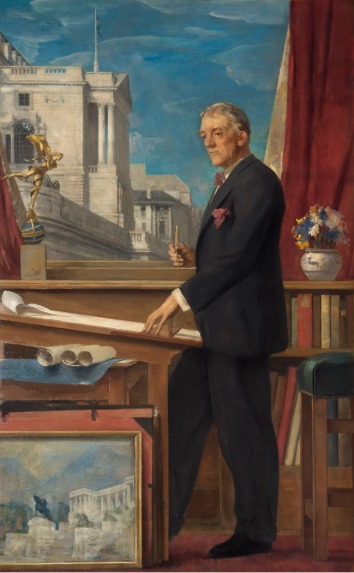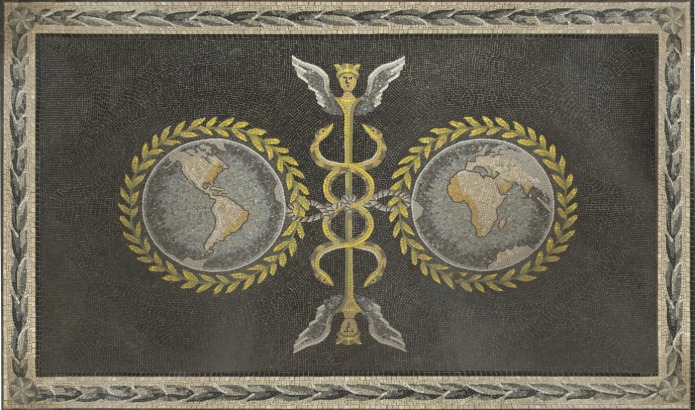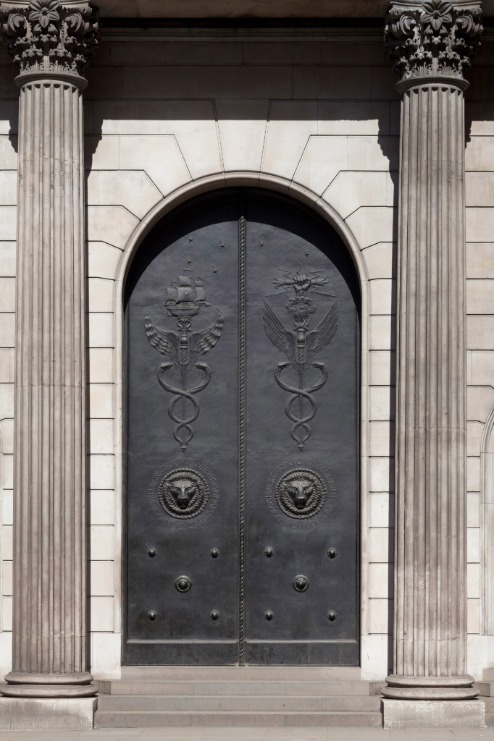Blog
Jennifer Adam and Alice Beagley
Herbert Baker (1862 to 1946) was a prominent British architect who oversaw the rebuilding of the Bank of England between 1925 and 1939. Born in Cobham, Kent, Baker showed interest in pursuing an architectural career from a young age. In 1880, he trained professionally under the guidance of his cousin Arthur, before joining the architecture firm Ernest George & Peto. Whilst studying at the Royal Academy School of Design, he often went on sketching trips across Britain and Northern Europe. Throughout his career, Baker designed a variety of public buildings, private homes, and monuments across the world, at a time that the British empire was near its territorial peak. By 1900, Baker had an extensive portfolio of high-profile architectural projects and was made a Fellow of RIBA (The Royal Institute of British Architects) in recognition of his work.
This portrait is one of a series recording the Bank of England at the time of its reconstruction. Baker stands at his desk in front of the new building, surrounded by objects that reflect his career and influences. A Roman pot filled with flowers references his interest in classical archaeology, and the books depict his love of reading and writing. On his left is a model of the golden statue known as Ariel, which is on the roof of the Bank today. At the bottom is a painting of the Rhodes Memorial, designed by Baker in 1906 to honour his early patron, Cecil Rhodes.
Baker met Rhodes (who was Prime Minister of the Cape Colony) during a chance encounter in 1892. At the time, Baker was living in the Cape Colony (modern South Africa), helping his brother run a fruit farm. Following this meeting, Rhodes commissioned Baker to renovate his official residence, Groote Schuur. Rhodes’ patronage led to commissions for Baker to design and renovate private homes and public buildings across Southern Africa.
Rhodes was keen for Baker to establish an ‘architectural language’ for public buildings which was largely inspired by Greek and Roman architecture. To further Baker's work on this, Rhodes sponsored Baker's Grand Tour of archaeological sites in Italy, Egypt and Greece, which had a lasting impact on Baker's designs. As part of this architectural language, Baker positioned these buildings to make them look dramatic and imposing against the South African landscape, showing how architecture could be used to project imperial power. This approach embodied Rhodes' vision of a 'united' South Africa (though the real intention was to bring British and Dutch settlers together whilst excluding Black South Africans). Rhodes was a staunch imperialist, and his belief in the superiority of the ruling white classes over Black South Africans was a precursor to the apartheid regime (which was enforced in 1948 throughout South Africa up until the early 1990s).
Rhodes' patronage ultimately cemented Baker's career and reputation as an imperial architect. Baker later went on to write a biography on Rhodes, and the inclusion of Baker’s Rhodes Memorial in the painting could be perceived as Baker showing his gratitude for Rhodes' support. When interpreting Baker's career and works, it’s important to consider his links to Rhodes and how Rhodes would have influenced Baker’s perceptions of race and imperialism in the context of the British empire in the early 20th century.
Baker’s experience with major public buildings led to another commission in 1912 for the new British colonial centre of New Delhi in India. This time, Baker combined European classical composition (to represent government, law and order) with traditional Indian architectural features. The project was a contemporary symbol of the imperial agenda, which suggested that Indians could only politically elevate themselves by adding their own cultural references to British constitutional structures. Today, this approach is recognised as one of the most problematic core ideologies of imperialism.
After the First World War, Baker also worked on the architectural designs of cemeteries for the fallen troops from Commonwealth countries. He designed 113 war cemeteries throughout France and Belgium, and 24 war memorials across England. In 1920, The Bank of England appointed Baker as architect to modernise the building whilst trying to preserve some of John Soane’s original features in the process.
The importance of symbolism in Baker's work is clearly visible at the Bank of England. A combination of grand, neoclassical architecture and modern sculptural decoration was adopted to give the central bank an air of 'permanence in progress', and to depict a constant, modern and dependable organisation. Its place at the centre of what was then a global British empire can also be seen in elements of the the decoration, sculptures and mosaics throughout the building.




